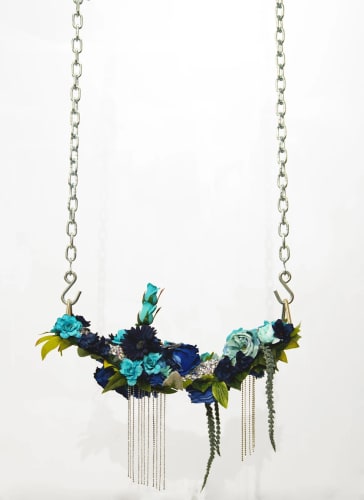![]()
The Black body is constantly attacked, violated, dehumanized. So, what happens when it is completely removed from a work of art? When artists of color pivot the focus away from the body and toward a different form of representation?
With the title "Elegies," it would be easy to make the phonic connection to eulogy and simplify the exhibition to one of tragedy and mourning. While those themes are present, this oversimplification would dismiss the layers of identity, culture, and the reclamation of the still life practice found in Elegies: Still Lifes in Contemporary Art.
The exhibition is now on view through Feb. 19, 2023 in the Jepson Center’s Levitt & Varnedoe Galleries.
Around 2016, New York-based independent curator Monique Long began noticing portrait artists of color shifting their practice into exploring still life. Initially, Long was only interested in the genre, but then began to tie pieces together based on the current events of targeted violence that many of the artists were reckoning with.
“I think one of the subtexts of the exhibition, like an anthology, is to sort of characterize a moment or a period or an era, and an exhibition does that as well,” says Long. “Clearly some of the artists are reckoning with civic unrest, you know, racial discourse, and the status of Blackness in this moment and responding to that in a particular way.”
However, she emphasizes that not every artist is responding in the same way. She even had to convince some artists to contribute their work to the show because they didn’t necessarily associate their pieces with Long’s concept.
While she considers Devan Shimoyama’s swings For Tamir VII and For Tamir VIII, tributes and memorials to the late Tamir Rice, the “soul of the show,” she considers the pieces as such more for how they draw the viewer’s sightline than their concept.
The industrial vinyl playground swings, embellished with deep purple and rich blue silk flowers, shimmering rhinestones, jewelry, chains and other found objects bring an almost imperceptible movement and harrowing sentience to an exhibition centered around the rendering of inanimate objects.
“You know, making something out of nothing, making songs as we worked in the fields that are still part of the American lexicon today, or a quilt or our cuisine,” Long says. “It's an inclination of being able to meet our creative imagination, collectively, to assuage, to resist, to create beauty. It's a great way to characterize Black culture.”
Yes, the Black body is beautiful. Our skin, our hair, our figure instills awe, envy, and fear.
Yes, it is a form of resistance to take up space, claim seats at tables, raise our fists to the sky and shout, “Enough.” But we are so much more than our body. Our presence extends beyond the physical.
Yes, an elegy is typically a lament for the dead, but it is ultimately a poem of serious reflection, which is exactly what the exhibition invites the audience to do.

